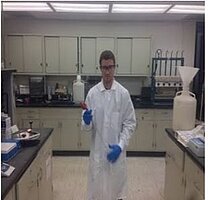Capturing the Lost Phosphorous by Enhanced Bioretention Cells Amended with Low-cost Adsorbents

Nicholas Lindstrom is a Civil Engineering Master of Science student at the University of North Dakota with an emphasis in environmental engineering. He holds a civil engineering bachelor’s degree at the University of North Dakota as well. Interests include stormwater mitigation systems, as well as BMP design. His current research involves an innovative and inexpensive method of removing dissolved phosphorus from stormwater runoff using waste materials.
Fellow: Nicholas Lindstrom
Advisor: Dr. Feng Xiao, Department of Civil Engineering, University of North Dakota.
Degree Progress: Master of Science in Civil Engineering, expected graduation in May 2018.
Capturing the Lost Phosphorous by Enhanced Bioretention Cells Amended with Low-cost Adsorbents
As an agrarian state, North Dakota purchases and consumes ~257,300 tons of phosphorus (P)-fertilizers annually for growing crops. P-fertilizers are also heavily used in lawns and gardens in rural and urban areas. Continuous use of conventional, highly soluble (quick-release) fertilizers, however, has deleterious long-term effects on the soil fertility and water quality. The runoff of phosphorus (P) from agricultural and urban lands is major contributor to the impairment of 24,403 acres of lakes of reservoirs in the North Dakota. The water recourses managers face a continuous challenge to manage P pollution in runoff and to minimize the adverse impacts of P discharge on surface water. An urban stormwater BMP is believed to be a 'best' way of treating or limiting pollutants especially suspended solids and heavy metals in stormwater runoff. However, the removal of P in conventional stromwater BMPs is minimum. This project proposes to develop and experiment with an enhanced bioretention cell amended with low-cost waste materials that can strongly retain P and reduce P loadings to surface water. This approach may also be applied to other popular BMPs, including biofilters (swales and strips). The enhanced bioretention cells are expected to effectively capture P runoff of snowmelt and rainfall to surface water, thus protecting the water resources.
Project Objectives:
The specific objectives are to 1) study the adsorption of phosphate on the low-cost adsorbents in batch adsorption studies; and 2) investigate the removal of PO4-P in bioretention cells amended with the adsorbents.
Research Progress:
Bench-scale adsorption experiments have been performed on the adsorption of PO4-P on a range of low-cost materials. Samples were analyzed for PO4-P according to Standard Methods section 4500-PE (ascorbic acid) with a minimum detection limit of 10 μg PO4-P/L. Adsorption kinetics, effects of humic and fulvic acids, and effects of pH were determined. Adsorbed concentrations (Cs) were calculated by mass balance. Adsorbent-free controls were run to automatically correct for ‘bottle’ losses. Adsorption isotherms were fit to the Freundlich model or the Langmuir model. Continuous-flow column experiments are ongoing to generate PO4-P breakthrough curve as a function of low-cost adsorbents, media volume fraction, and bed depth.
Significance:
The control of P pollution is a high priority in water resources management in North Dakota and many other states. This project will promote innovation and result in the development of enhanced bioretention cells by amending the bioretention media with PO4-P adsorbents. This project on the nexus of water resources and agriculture may lead to a mutually beneficial partnership between these two broad areas that results in further innovative technologies to improve the sustainability of both water resources and agriculture. Overall, the anticipated benefits of this project include:
- An innovative approach for capturing P based on the theory of inner-sphere complexation;
- Enhanced understanding of the interactions between PO4-P with Fe-based materials and minerals;
- An enhanced BMP that can be used in either agricultural, rural, and urban areas to reduce the runoff of P;
- Improved the sustainability and water quality of water resources.
Peer-Reviewed Journal Papers:
Nicholas Lindstrom and Feng Xiao. 2018. Removal of Phosphate by Bioretention Cells Enhanced with Low-cost Adsorbents. Manuscript in preparation.
Conference:
Feng Xiao, Ryan Hanson, and Nicholas Lindstrom. 2016. Interactions of Metallic Species with Thermally Air-oxidized Black Carbon (Char) In the Presence of Soil Organic Matter. 252nd ACS National Meeting (Philadelphia, PA, August 24, 2016).
Nicholas Lindstrom and Feng Xiao. October 2016. Phosphate Removal by Stormwater Best Management Practices: Elephant in the Room? Presented at the UND Graduate Day.
Nicholas Lindstrom and Feng Xiao. March 2017. Enhanced Phosphate Removal by Bioretention Cells Amended with Low-cost Adsorbents. AEESP Distinguished Lecture Series Seminar, Minneapolis, MN.

Feng "Frank" Xiao
Civil Engineering
Office: Upson II Room 260K
243 Centennial Drive Stop 8115
Grand Forks, ND 58202-8115
Telephone: 701-777-5150
Email: feng.xiao@UND.edu


